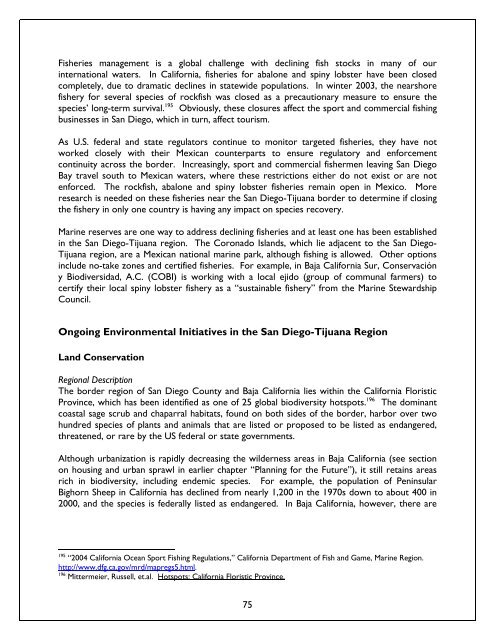Blurred Borders - International Community Foundation
Blurred Borders - International Community Foundation
Blurred Borders - International Community Foundation
You also want an ePaper? Increase the reach of your titles
YUMPU automatically turns print PDFs into web optimized ePapers that Google loves.
Fisheries management is a global challenge with declining fish stocks in many of our<br />
international waters. In California, fisheries for abalone and spiny lobster have been closed<br />
completely, due to dramatic declines in statewide populations. In winter 2003, the nearshore<br />
fishery for several species of rockfish was closed as a precautionary measure to ensure the<br />
species’ long-term survival. 195 Obviously, these closures affect the sport and commercial fishing<br />
businesses in San Diego, which in turn, affect tourism.<br />
As U.S. federal and state regulators continue to monitor targeted fisheries, they have not<br />
worked closely with their Mexican counterparts to ensure regulatory and enforcement<br />
continuity across the border. Increasingly, sport and commercial fishermen leaving San Diego<br />
Bay travel south to Mexican waters, where these restrictions either do not exist or are not<br />
enforced. The rockfish, abalone and spiny lobster fisheries remain open in Mexico. More<br />
research is needed on these fisheries near the San Diego-Tijuana border to determine if closing<br />
the fishery in only one country is having any impact on species recovery.<br />
Marine reserves are one way to address declining fisheries and at least one has been established<br />
in the San Diego-Tijuana region. The Coronado Islands, which lie adjacent to the San Diego-<br />
Tijuana region, are a Mexican national marine park, although fishing is allowed. Other options<br />
include no-take zones and certified fisheries. For example, in Baja California Sur, Conservación<br />
y Biodiversidad, A.C. (COBI) is working with a local ejido (group of communal farmers) to<br />
certify their local spiny lobster fishery as a “sustainable fishery” from the Marine Stewardship<br />
Council.<br />
Ongoing Environmental Initiatives in the San Diego-Tijuana Region<br />
Land Conservation<br />
Regional Description<br />
The border region of San Diego County and Baja California lies within the California Floristic<br />
Province, which has been identified as one of 25 global biodiversity hotspots. 196 The dominant<br />
coastal sage scrub and chaparral habitats, found on both sides of the border, harbor over two<br />
hundred species of plants and animals that are listed or proposed to be listed as endangered,<br />
threatened, or rare by the US federal or state governments.<br />
Although urbanization is rapidly decreasing the wilderness areas in Baja California (see section<br />
on housing and urban sprawl in earlier chapter “Planning for the Future”), it still retains areas<br />
rich in biodiversity, including endemic species. For example, the population of Peninsular<br />
Bighorn Sheep in California has declined from nearly 1,200 in the 1970s down to about 400 in<br />
2000, and the species is federally listed as endangered. In Baja California, however, there are<br />
195<br />
“2004 California Ocean Sport Fishing Regulations,” California Department of Fish and Game, Marine Region.<br />
http://www.dfg.ca.gov/mrd/mapregs5.html.<br />
196<br />
Mittermeier, Russell, et.al. Hotspots: California Floristic Province.<br />
75















